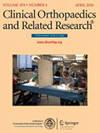Standardized Intraoperative Robotic Laxity Assessment in TKA Leads to No Clinically Important Improvements at 2 Years Postoperatively: A Randomized Controlled Trial.
IF 4.2
2区 医学
Q1 ORTHOPEDICS
引用次数: 0
Abstract
BACKGROUND Joint stability is a major factor associated with success after TKA. However, most assistive technologies, such as robotic-assisted TKA, do not incorporate a standardized laxity assessment. To address this gap, we opted to perform a randomized controlled trial comparing the results of a manual versus a robot-assisted TKA system with standardized laxity assessment. QUESTIONS/PURPOSES (1) Does robot-assisted TKA with a standardized laxity assessment provide superior patient-reported outcomes compared with conventional TKA with a manual tensioner, and does it result in a higher percentage of patients achieving the patient acceptable symptom state (PASS) thresholds 2 years after surgery? (2) Does robot-assisted TKA with a standardized laxity assessment provide different coronal alignment or coronal laxity compared with conventional TKA with a manual tensioner after surgery? METHODS This was a prospectively registered randomized trial performed at a single center in Belgium. Patients with end-stage knee osteoarthritis unresponsive to conservative treatment were eligible. Exclusion criteria included severe deformity, limited ROM, prior fractures, infection, ligament insufficiency, and neurologic conditions. Between September 2020 and August 2022, we randomized 60 patients to receive TKA either with a manual tensiometer (n = 30) or a robotic-assisted TKA with an imageless system using a standardized laxity system (distraction of the tibiofemoral joint with 80N throughout ROM; n = 30). Of those, 100% (30 of 30) and 90% (27 of 30) of patients were available for follow-up at 2 years in the robotic-assisted and conventional groups, respectively. In both groups, a posterior stabilized implant was used. Patient-reported outcome measures (Knee Society Score [KSS], WOMAC, and 5-level EuroQol 5-domain scores) were obtained preoperatively and at 2 years postoperatively. Coronal alignment and implant position were evaluated on full-leg weightbearing radiographs. Stress radiographs were obtained to assess coronal laxity in 10° of flexion. There were no differences between the groups in baseline characteristics of age, BMI, side, gender, hip-knee-ankle axis, ROM, or patient-reported outcome measures. To account for multiple comparisons in this study, a Bonferroni correction was applied. All differences between both groups were evaluated considering minimum clinically important difference values for patients who have undergone TKA. The power analysis indicated 80% power to detect a clinically meaningful difference of 9.7 points in KSS function score, with an alpha of 0.05. RESULTS We found no clinically important differences in patient-reported outcomes 2 years after surgery between the conventional and the robotic group (for example, the KSS function score in those groups was 66 ± 20 versus 74 ± 24, respectively, mean difference 8 [95% confidence interval (CI) -3 to 21]; p = 0.18), and no difference in the proportion of patients in those groups who achieved the PASS on any outcomes score (for example, the percentage of patients achieving the PASS for the WOMAC was 4% [1 of 27] versus 3% [1 of 30], respectively, OR 0.9 [95% CI 0 to 15]; p > 0.99). Likewise, there were no differences in postoperative hip-knee-ankle axis between the conventional and the robotic groups, respectively (1° ± 2° varus versus 1° ± 3° varus; p > 0.99) or in coronal-plane laxity (6° ± 3° versus 7° ± 2° in the conventional cohort; p = 0.73). CONCLUSION Based on the absence of clinically important differences in outcome scores or any differences in the proportion of patients who achieved the PASS on those scores (as well as the absence of meaningful differences in alignment or soft tissue tension), we recommend against the routine use of robotic TKA with objectified laxity assessment because it adds costs and time to these procedures without delivering benefits that patients might perceive. Future studies might, however, be able to identify patient-specific laxity targets to improve patient outcomes. LEVEL OF EVIDENCE Level I, therapeutic study.一项随机对照试验:标准化术中机器人松弛度评估在TKA术后2年没有显著的临床改善。
背景:关节稳定性是 TKA 术后成功的一个重要因素。然而,大多数辅助技术,如机器人辅助 TKA,都没有采用标准化的松弛评估。为了填补这一空白,我们选择进行一项随机对照试验,比较人工与机器人辅助 TKA 系统的标准化松弛评估结果。问题/提案(1)与使用人工拉力器的传统 TKA 相比,使用标准化松弛评估的机器人辅助 TKA 是否能提供更好的患者报告结果,是否能使术后 2 年达到患者可接受症状状态(PASS)阈值的患者比例更高?(2)与使用手动拉力器的传统 TKA 相比,术后进行标准化松弛度评估的机器人辅助 TKA 是否能提供不同的冠状位对齐或冠状位松弛度?对保守治疗无反应的终末期膝关节骨性关节炎患者均符合条件。排除标准包括严重畸形、活动度受限、既往骨折、感染、韧带功能不全和神经系统疾病。在2020年9月至2022年8月期间,我们对60名患者进行了随机分组,分别接受手动张力计(n = 30)或使用标准化松弛系统的无图像系统机器人辅助TKA(在整个ROM中以80N牵张胫股关节;n = 30)。其中,机器人辅助组和传统组分别有100%(30人中的30人)和90%(30人中的27人)的患者在2年后接受了随访。两组患者均使用了后方稳定植入物。术前和术后2年分别进行了患者报告结果测量(膝关节社会评分[KSS]、WOMAC和5级EuroQol 5域评分)。通过全腿负重X光片对冠状位对齐和植入物位置进行评估。应力X光片用于评估屈曲10°时的冠状面松弛情况。两组在年龄、体重指数、侧位、性别、髋-膝-踝轴线、ROM或患者报告的结果测量等基线特征方面没有差异。为考虑本研究中的多重比较,采用了 Bonferroni 校正。两组之间的所有差异均根据接受过 TKA 的患者的最小临床重要差异值进行评估。结果我们发现,传统组和机器人组术后2年患者报告的结果没有临床重要差异(例如,两组患者的KSS功能评分分别为66±20和74±24,平均差异为8[95%置信区间(CI)-3至21];P = 0.例如,WOMAC 达到 PASS 的患者比例分别为 4% [27 人中的 1 人] 与 3% [30 人中的 1 人],OR 0.9 [95% CI 0 至 15];P > 0.99)。同样,传统组和机器人组的术后髋关节-膝关节-踝关节轴线分别为(1° ± 2° 曲张与 1° ± 3° 曲张;P > 0.99)和冠状面松弛(传统组为 6° ± 3° 与 7° ± 2°;P = 0.73),两者之间没有差异。结论基于在结果评分上没有临床重要差异,或在这些评分达到 PASS 的患者比例上没有任何差异(以及在对位或软组织张力上没有有意义的差异),我们建议不要常规使用带有客观松弛评估的机器人 TKA,因为它增加了这些手术的成本和时间,却没有带来患者可能感受到的益处。不过,未来的研究可能会确定患者特定的松弛目标,以改善患者的预后。
本文章由计算机程序翻译,如有差异,请以英文原文为准。
求助全文
约1分钟内获得全文
求助全文
来源期刊
CiteScore
7.00
自引率
11.90%
发文量
722
审稿时长
2.5 months
期刊介绍:
Clinical Orthopaedics and Related Research® is a leading peer-reviewed journal devoted to the dissemination of new and important orthopaedic knowledge.
CORR® brings readers the latest clinical and basic research, along with columns, commentaries, and interviews with authors.

 求助内容:
求助内容: 应助结果提醒方式:
应助结果提醒方式:


